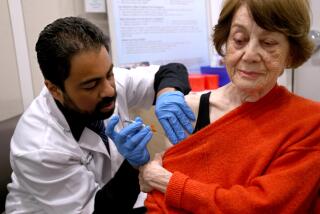California avoids worst of flu, but probably not for long
- Share via
California public health officials are bracing for an increase in new flu patients in the coming weeks as the influenza outbreak that has engulfed 47 other states gears up here.
Flu activity in California has been accelerating since late December and usually doesn’t peak until February or March, state health officials said Friday. In Los Angeles County, 17 of the 71 confirmed flu cases this season have been recorded since Jan. 4.
“Right now in Los Angeles, we’re on the upswing,” said Dr. Sharon Orrange, an internist and clinical professor at the Keck School of Medicine of USC.
Dr. Ron Chapman, director of the state Department of Public Health, urged Californians to get flu shots if they hadn’t already. The vaccine is closely matched to the strains in circulation this year, he said Friday. State and local officials stressed that plenty of doses are available.
Officials at the Centers for Disease Control and Prevention in Atlanta updated their assessment of the nation’s flu epidemic on Friday and said only three states — California, Mississippi and Hawaii — have not reached the threshold of having “widespread flu activity.”
But that won’t remain the case for long. By next week, the flu is likely to be widespread in California too, said Dr. Gil Chavez, the state epidemiologist.
“California has been the laggard,” added Dr. Jonathan Fielding, director of the Los Angeles County Department of Public Health. “We expect it to continue to grow and peak sometime in the next month.”
Californians may be feeling the same complacency about getting a flu shot as people did in places like Pennsylvania before the outbreak hit there. If so, that’s very dangerous, said Dr. Jeffrey Jahre, chief of infectious diseases at St. Luke’s University Health Network in Bethlehem, Pa.
“There’s almost a dropping of the guard,” he said, because the last two years have been relatively flu-free. “People assume that, ‘Well, this is the new paradigm, that’s the way things are going to be.’”
Not this year. The flu season got off to an unusually early start in mid-November. As infections ramped up, first in the Southeast and then elsewhere, hospitals in hard-hit regions have been overwhelmed with patients complaining of severe fever, chills and respiratory woes. Antiviral treatments like Tamiflu can curb symptoms, but only when they’re taken in the first 48 hours.
“This year is very severe,” said Terry Burger, director of infection control and prevention at the Lehigh Valley Health Network in eastern Pennsylvania. One hospital in her system set up what she calls a “M.A.S.H.-like tent” to process flu patients outside the emergency room. Another took over an unoccupied unit of a hospital building to treat patients.
“What we are currently seeing exceeds all of what we saw last year,” she said.
Some hospitals are having trouble responding because so many of their doctors and nurses are ill, said Dr. Brien Barnewolt, chairman of the department of emergency medicine at Tufts University Medical Center in Boston.
“It’s difficult to run a hospital when your own staff are calling in sick,” he said.
So far this flu season, 28,747 confirmed cases have been reported to the CDC. The true number is certainly far higher, but many people who get the flu don’t go to their doctors, and others who do are not tested to confirm infection.
The CDC also tracks flu-related deaths in children; there have been 20 since the flu season began.
Public health experts emphasized that the earlier-than-usual start to the flu season this year won’t necessarily translate into more illnesses or deaths overall.
There’s never a simple explanation for why one season’s flu hits harder than another’s, said Dr. Arnold Monto, an epidemiologist at the University of Michigan in Ann Arbor. But he said this year’s severity might be related to characteristics of the strain that’s predominant, known as H3N2.
For unknown reasons, “H3N2 has been for years the one that is usually the culprit when you see excess mortality and other severe indicators,” he said. To make matters worse, it’s been several years since the last big H3N2 outbreak, so people are likely to have less immunity to it.
Monto also said it was impossible to know whether California would fare as poorly as hard-hit states like Pennsylvania and Massachusetts.
“Flu has a mind of its own,” he said. “Sometimes you get these differences in areas.”
Inside the Lehigh Valley Hospital-Cedar Crest emergency room in Allentown, Pa., on Friday, 48-year-old Amanda McDonald leaned back against her chair and breathed through a yellow face mask. Her chest felt tight, she hadn’t slept in days, and her body ached.
She said she had planned to get a flu shot but didn’t get around to it in time. “I wish I’d gotten vaccinated,” she said.
Robin Jacoby, a hospital administrator in Dallas, got a flu shot but came down with the flu anyway while visiting her family in Boston over the holidays. She said the illness lasted for nearly two weeks and hit harder than the pneumonia she contracted last year.
“You just ache in every bone in your body,” said Jacoby, 67. “You really feel that you’ve been hit by a sledgehammer.”
Despite anecdotal reports that this year’s vaccine has not been working, the CDC released preliminary data on Friday that show it does prevent illness.
Analyzing a sample of 1,155 children and adults at five test sites, researchers found that people who had received the vaccine were 62% less likely to wind up in a doctor’s office with the flu than people who hadn’t. Those numbers indicate that the vaccine is working as anticipated, said Monto, who contributed to the report.
“People expect the vaccine will protect people absolutely, but that isn’t the case,” he said. “We have a good vaccine, but not a great vaccine. We do see failures.”
The vaccine is known to provide less protection in the elderly, for instance, than in younger healthy adults. Of the thousands or tens of thousands of people who die of the flu each year in the U.S., nearly 90% are 65 or older.
CDC Director Thomas Frieden said Friday that although public health officials hoped better vaccines would become available in the future, the immunizations available were still the “single most important step” for prevention.
As of Nov. 17, the CDC reported in December, only about 35% of American adults had received flu immunizations.
Orrange, of USC, said her practice had done a better job of vaccinating patients this year and that most of the people who had not yet received shots or FluMist inhalations have skipped them by choice.
Brown reported from Los Angeles and Semuels from Allentown.








